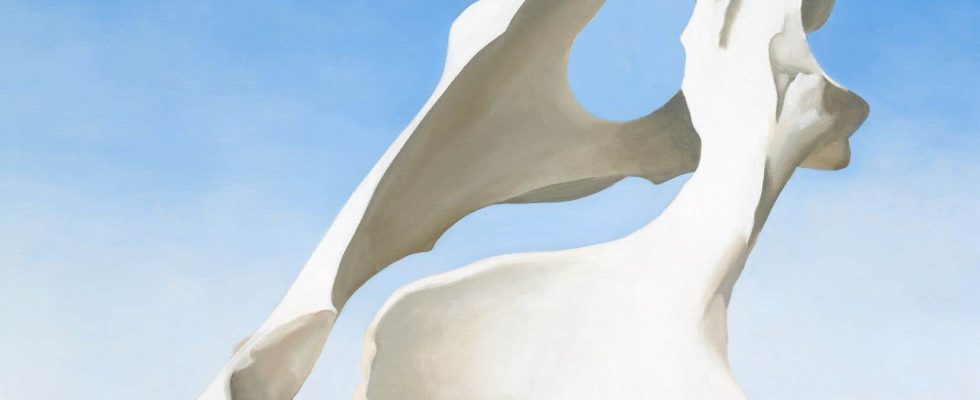From an animal bone, one made monumental sculptures, the other, detailed paintings. Living an ocean apart, British sculptor Henry Moore and American painter Georgia O’Keeffe created strangely parallel universes during the 20th century.e century. Their works, initially inspired by surrealism, on the verge of abstraction, demonstrate a keen observation of nature. Both were passionate about archeology and spent long days surveying the territory, collecting the stones, shells, flowers and bones that inspired their works.
Until June 2, the Montreal Museum of Fine Arts (MMFA) is offering an exhibition bringing together these two artists. It is Georgia O’Keeffe and Henry Moore. Giants of modern artwhich opens its doors on February 10 on Sherbrooke Street in Montreal.
Anita Feldman, curator at the San Diego Museum of Art, was already a specialist in the work of Henry Moore when she visited the Georgia O’Keeffe Museum in New Mexico. She was surprised to find, in the artist’s preserved studio, small objects collected in nature. “I thought, ‘Henry Moore would have loved that,’” she says. She decides to organize a joint exhibition, a sort of posthumous dialogue between the two artists, who have probably not crossed paths more than once during their lives. It is from his work that the MMFA exhibition emerged, a Canadian first, which centers on the reconstructed workshops of both, exhibiting the stew bones or ram’s horns that inspired to one a landscape or to the other a sculpture.
While O’Keeffe collected dark stones from the Bisti Badlands, “the Black Place”, to display in her home, Moore carved some of her first sculptures from the preciously preserved ferruginous pebbles of the Norfolk beaches.
Moore painted the details of the stones of Stonehenge, which he considered a work of art, while O’Keeffe focused on the shape of the stones supporting the ancient constructions of the Incas in Peru.
Bone: object of fascination
For both artists, the bone, far from symbolizing death and the end, is a symbol of resilience and density, lightness and strength. A rare painting painted by Georgia O’Keeffe in the years following her husband’s death, Spring, exhibits a vertebra floating in the sky among the flowers. Moore was inspired by the shape of a bone to create human silhouettes.
Both were fascinated by skulls, these solid structures which hide complex, organized matter. Moore created the so-called abstract sculpture Oval with points by studying the interior of an elephant skull, “where two points come together without touching inside an internal shell.” Next door, a painting by Georgia O’Keeffe offers an opening in the skull of a mule, in the middle of a desert decor and poinsettias.
Georgia O’Keeffe decorated the animal skulls that adorned her paintings with blooming flowers, while Henry Moore used walnut husk to give the stone the color of bone.
In an interview that is broadcast on loop alongside the exhibition, Moore explains his fascination with human bones, which take on a different appearance depending on the angle from which you look at them, a defining characteristic of sculpture, he says.
While bones, of animals and humans, provide a strong framework for soft elements like muscles and organs, he observes, a shell shelters fragile tissues.
This notion of an outer shell protecting vulnerable elements, or of a larger one framing the smaller one, is very present in Moore’s work, notably in the series of helmets, developed from the outbreak of the Second World War and continued well beyond. During this war, Moore also drew the London Underground stations, where people crowded together, night after night, to protect themselves from bombing during the blitzes.
“He saw mothers protecting children,” says Anita Feldman. Moore himself was a survivor of the First World War.
O’Keeffe, for his part, observed the evolution of a flower, as in the series Arisème little-preacher. This series shows, in six paintings, how a flower gradually blooms to finally reveal its delicate interior.
From the infinitely large to the very small
Both artists played enormously with scales of magnitude. O’Keeffe observed the sky and landscape through the bone of a fox, while Moore’s photographs, which appear to evoke canyons, are in fact enlarged shapes of beef bones from a stew.
It is also interesting to note that Moore, better known for his monumental sculptures (two of which are permanently exhibited in front of the MMFA), also worked on a very small scale. In fact, only 10% of these models have been enlarged, says Anita Feldman.
“He believed that each work had an ideal size,” she says. The sculpture titled Three pieces no 3. Vertebrae was, for example, reproduced in giant size in front of Dallas City Hall, and passers-by can move comfortably between each “vertebra”. The exhibition reveals two smaller models.
The exhibition is divided into thematic rooms, the first focusing on the influence of surrealism, the others focusing on bones, workshops, stones, flowers and shells, and finally landscapes.
The MMFA program includes a conference by art historian Barbara Buhler Lynes, who participated in the catalog accompanying the exhibition.
